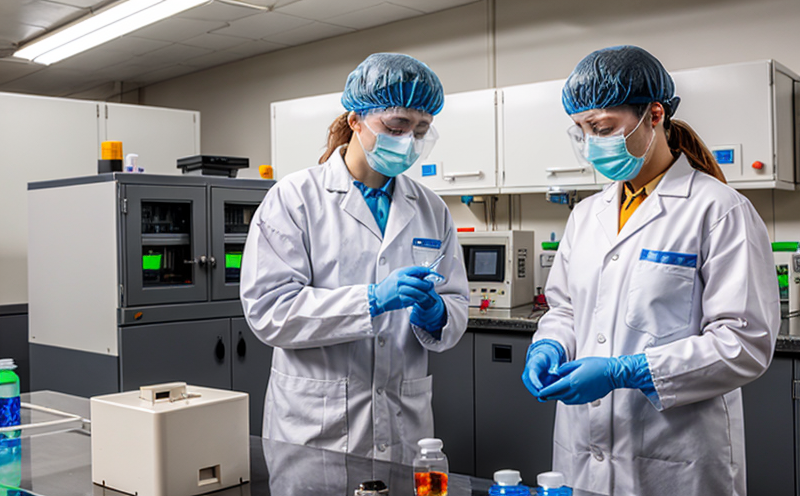ISO 68619 Acrylamide Quantification in Baby Foods
The quantification of acrylamide in baby foods is critical for ensuring the safety and quality of food products, especially as acrylamide has been linked to potential health risks. ISO 68619 provides a standardized method for measuring acrylamide levels in processed food items. This service ensures compliance with regulatory requirements and helps maintain consumer trust.
Acrylamide forms during the high-temperature processing of certain carbohydrates, particularly in carbohydrate-rich foods like baby cereals, biscuits, and snacks. The primary sources are cooking methods such as frying, baking, and roasting at temperatures above 120°C (248°F). Understanding acrylamide levels is crucial for food manufacturers to minimize exposure while still delivering safe products.
The testing process involves extracting acrylamide from the sample using a solvent. The extracted compound is then analyzed by gas chromatography with mass spectrometry (GC-MS), an analytical technique that can accurately detect and quantify acrylamide in complex matrices. This method ensures reliable results, which are essential for compliance with international standards.
The service provider adheres to ISO 68619 guidelines, which specify the sample preparation steps, chromatographic conditions, and the detection limits. The process begins by selecting representative samples from different batches or production lines. Samples are then ground into a fine powder before extraction. Extraction solvents should be chosen based on their ability to effectively dissolve acrylamide without interfering with the GC-MS analysis.
Once extracted, the sample is analyzed using GC-MS, which separates and identifies components within the mixture. The chromatogram shows peaks corresponding to various compounds present in the sample. Acrylamide’s peak can be identified based on its retention time and mass spectrum. Quantification is achieved by comparing this peak area with a standard curve prepared from known concentrations of acrylamide.
Understanding the acrylamide content allows manufacturers to implement process adjustments, such as reducing baking temperatures or optimizing ingredient combinations. This not only ensures compliance but also helps in maintaining product quality and safety standards. Compliance with ISO 68619 is mandatory for companies operating within regulated markets like the European Union (EU) and the United States.
The testing procedure follows a structured approach, starting from sample selection to final reporting. Each step is meticulously documented to ensure traceability and accuracy. The results are reported in parts per million (ppm), which allows stakeholders to assess risk levels effectively.
| Applied Standards | Description |
|---|---|
| ISO 68619-1 | Sampling and preparation of samples for acrylamide determination in foodstuffs |
| ISO 68619-2 | Determination of acrylamide in foodstuffs by gas chromatography with mass spectrometry (GC-MS) |
| Applied Standards | Description |
|---|---|
| ISO 68619-3 | Evaluation of acrylamide content in processed foodstuffs for infants and young children |
| ISO 68619-4 | Interpretation guidelines for acrylamide levels in baby foods |
The service provider also offers support beyond just compliance testing. We assist manufacturers in implementing risk management strategies and provide insights into best practices to reduce acrylamide formation during processing.
- Conducting baseline studies to identify acrylamide levels across various products.
- Developing mitigation plans based on the findings of these studies.
- Training staff in proper sampling techniques and sample preparation.
By adhering to ISO 68619, food manufacturers can ensure that their products meet stringent safety standards. This not only protects consumer health but also enhances brand reputation and market credibility.
Applied Standards
| Standard | Description |
|---|---|
| ISO 68619-1 | Sampling and preparation of samples for acrylamide determination in foodstuffs |
| ISO 68619-2 | Determination of acrylamide in foodstuffs by gas chromatography with mass spectrometry (GC-MS) |
| ISO 68619-3 | Evaluation of acrylamide content in processed foodstuffs for infants and young children |
| ISO 68619-4 | Interpretation guidelines for acrylamide levels in baby foods |
Industry Applications
The quantification of acrylamide is particularly important for the food and feed sectors. This service is applicable to manufacturers, processors, and distributors involved in producing and distributing baby foods. Compliance with ISO 68619 helps these entities meet regulatory requirements and protect consumer health.
For quality managers and compliance officers, this service provides a clear roadmap to ensure that products are safe for consumption by infants and young children. R&D engineers can use the results to refine processing methods and ingredient formulations. Procurement teams benefit from having reliable data on acrylamide levels in raw materials and final products.
Use Cases and Application Examples
- Baseline Study: A major baby food manufacturer conducted a baseline study to determine the acrylamide content across different product lines. This helped them identify high-risk products and implement targeted mitigation strategies.
- New Product Development: A startup in the infant formula industry used ISO 68619-accredited testing to ensure that their new product met stringent safety standards before launch.
- Supply Chain Management: A large food distributor ensured consistency across its supply chain by regularly testing acrylamide levels in incoming raw materials and processed products.
| Applied Standards | Description |
|---|---|
| ISO 68619-2 | Determination of acrylamide in foodstuffs by gas chromatography with mass spectrometry (GC-MS) |
| ISO 68619-3 | Evaluation of acrylamide content in processed foodstuffs for infants and young children |





